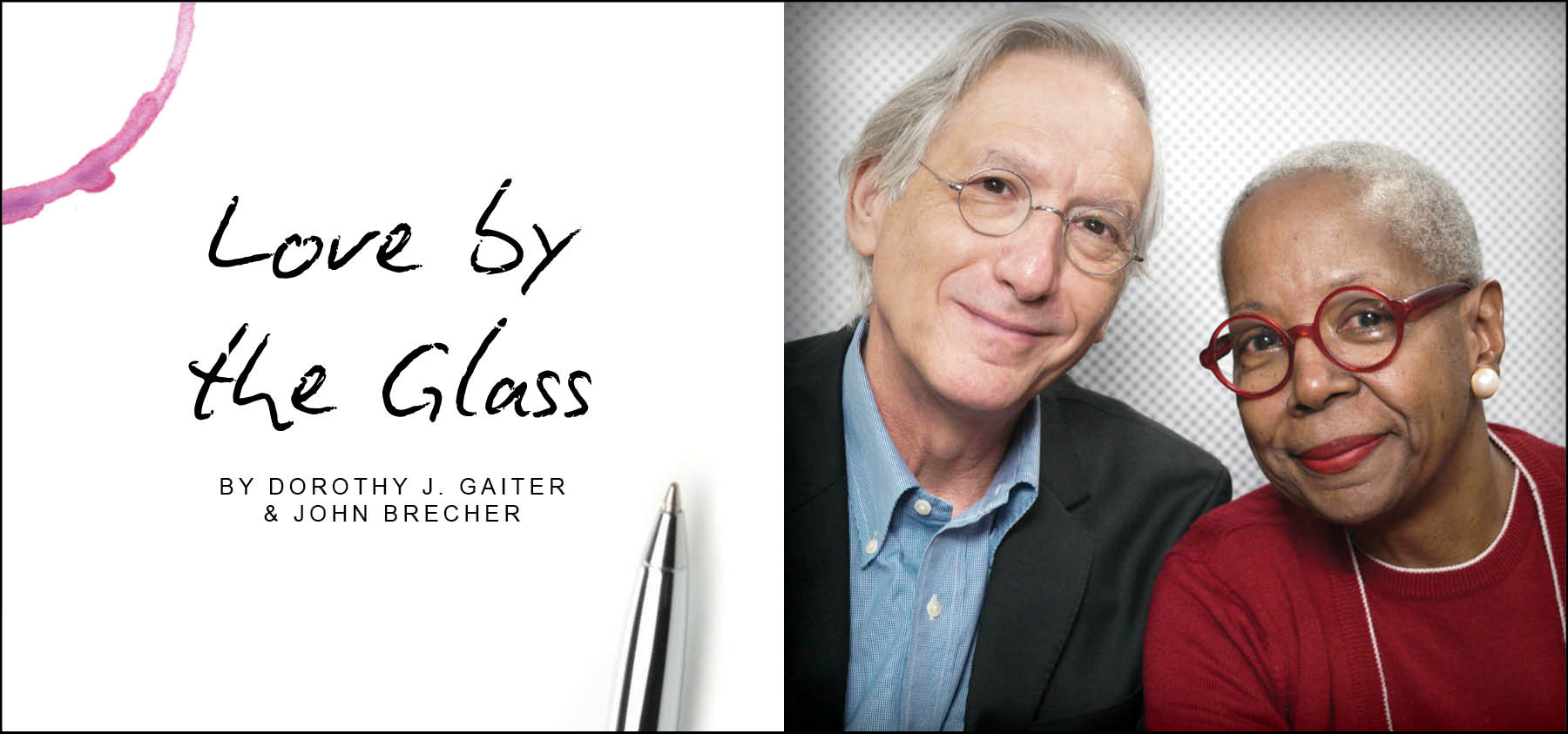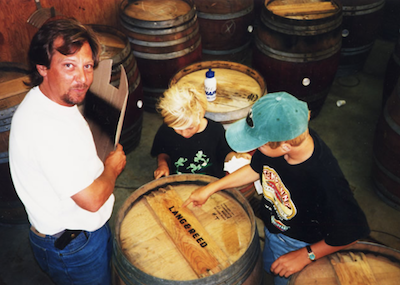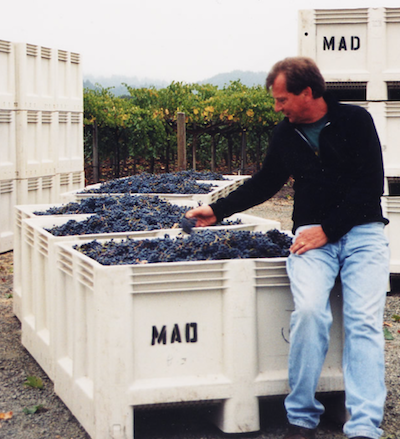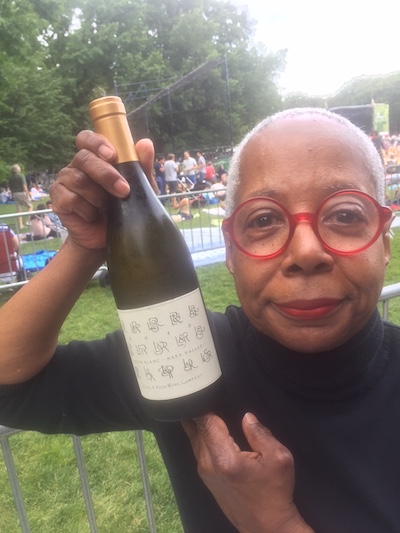
Have you noticed the proliferation of “The” wines on shelves? The Prisoner was the breakout hit, of course, but there’s The Chook, The Vegan Vine, The Pinot Project, and so many others. Walk into a wine store today and you are awash in definite articles.
We spend our lives shopping for wine and we had never really noticed this. But John Skupny had – and we’re not surprised.
Skupny has one of the keenest eyes in the wine business, with the wisdom and experience to put what he sees into the context of a story. If we were going to nominate someone to write a first-person account of American wine over the past half-century, he’d be atop our list. And, oh: He also makes outstanding wine, a long-time favorite of ours that you should try.
If you’ve never heard his name, that’s probably because you won’t find it in large type on a label – and there’s a story behind that, too.
Stories matter, and here’s why. Soon after we met in 1973, we discovered wine together. We liked it a lot. Then we visited wine country and met winemakers. These were the days when owner-winemakers poured in the tasting rooms, when David Rafanelli got off his tractor to offer us a taste. When we met winemakers, that’s when we really fell in love with wine. We realized that each good bottle was an expression of a winemaker’s soul. So when we drank a well-made wine, we not only talked about its taste, but what might be the winemaker’s intent, what vision lay behind it, the story.
This is why we’re nervous about the number of small family operations being bought out by billionaires and giant corporations. Not that there’s anything wrong with billionaires or giant corporations. But we fear something special will be lost if the John Skupnys can no longer make a go of it.
 Skupny and his wife, Tracey, own Lang & Reed Wine Co. in Napa, which produces 4,000 to 5,000 cases, mostly Cabernet Franc, a little Chenin Blanc and a small amount of a red Bordeaux blend called Right Bank. They made a prototype Cabernet Franc in 1993 and their first commercial release in 1996. When you drink one of their wines, this is the story you will taste:
Skupny and his wife, Tracey, own Lang & Reed Wine Co. in Napa, which produces 4,000 to 5,000 cases, mostly Cabernet Franc, a little Chenin Blanc and a small amount of a red Bordeaux blend called Right Bank. They made a prototype Cabernet Franc in 1993 and their first commercial release in 1996. When you drink one of their wines, this is the story you will taste:
(Photo, left: John and Tracey of Lang & Reed Wine Co.)
John, 65, and Tracey, 63, met in high school in Kansas and got married in 1977 after college. Both worked in restaurants and became increasingly interested in wine. “Instead of beer and marijuana, we started drinking wine,” Skupny told us when we called him. Their interest grew into a passion as they both worked as wine stewards and wine buyers for different restaurants. Skupny eventually managed wine for one of Kansas City’s best restaurants when Americans were just beginning to discover this wonderful, mysterious beverage. “We sold magnums of ’70 Lafite, but we also sold Lancers and Mateus. We had to have the whole range in those days.”
Most wines on the list then were European, “but the California thing was where the action was. That was where we were seeing the biggest and most exciting things happening,” he said.
The restaurant sent him on a trip to California in 1979. Tracey went along. Their first stop was Inglenook because they served a lot of that by the glass at the restaurants where they worked. The next day, he saw Bernard Portet of Clos du Val, Jerry Luper at Chateau Montelena, and, later in the day, Chuck Wagner at Caymus Vineyards. “I had a path,” Skupny said. “I knew we needed to move to California.”
So they did. A large wine marketing and sales company, which represented 10 wineries, “all family-owned wineries at the time,” hired him and moved them to San Francisco in 1980. There, Skupny learned to write wine descriptions and market wine. “I learned how to give good copy,” as he put it. “In the premium business, it has to be an authentic story.”
They moved to Napa in 1984, where Skupny worked for the Wagners at Caymus. “My first week working there the big question was whether we could take the estate bottled Cabernet from $10 a bottle to $12 a bottle. Then Joe Heitz came out with $14 for his, so that ended that discussion.”
Over the next years, Skupny worked with or for one Napa icon after another in marketing and sales: Portet, Tony Soter, Randy Dunn, Jason Pahlmeyer, John Konsgaard. He learned about wine from every one. Portet and Chuck Wagner, especially, taught him so much about how wine is made, in the vineyard and in the winery. “Bernard taught me that things were incremental, that just because 4 percent Cabernet Franc made this wine taste better or more aromatic, 6 percent didn’t mean it’s going to be even more so.”
And then there was Francis Ford Coppola. The director was trying to make something more of his Napa winery, Niebaum-Coppola Estate Winery. “It had just been a bad hobby for many years,” Skupny said. In “The Far Side of Eden,” author James Conaway explains why Skupny was hired as general manager: “Skupny worked for Caymus Vineyards and there earned a reputation as an effective, straightforward, pleasant administrator…with a degree in fine arts and that rarity among winery managers, a sense of humor.” Effective, he was. Skupny’s resume notes that he was “the key negotiation team leader for the acquisition and rejoining of the historic Inglenook property to the Niebaum estate property.” Giant Heublein owned the chateau and some acreage and was contemplating selling to Canandaigua (now Constellation). After four years, Skupny moved on, but he says Coppola really taught him how to tell a story.
Tracey was active in philanthropic endeavors and ultimately worked in management at Spottswoode winery, which she left recently as director of sales. In the early 1990s, “we decided it was time to build our own equity in something,” Skupny said, although at that point they had no winemaking experience. Early on, though, he turned his marketing savvy into a successful consulting business on the side. The couple has served on the Napa Valley Vintners’ board, he as president of the NVV and Auction Napa Valley in 1996, and they have co-chaired the Premiere Napa Valley barrel auction.
Anyone who is thinking of starting a winery shouldn’t proceed without reading Skupny’s chapter in a book called “Successful Wine Marketing.” He lays out how they decided to do things the way they did, including not owning a winery or land.  And the name? “We did not think Skupny was an appropriate name to put on a wine label; it might be appropriate for beer or pickles, but definitely not wine,” he wrote. Instead, they named the business after their sons, Lang, now 32, and Reed, now 35 -- “more generic,” as Skupny put it.
And the name? “We did not think Skupny was an appropriate name to put on a wine label; it might be appropriate for beer or pickles, but definitely not wine,” he wrote. Instead, they named the business after their sons, Lang, now 32, and Reed, now 35 -- “more generic,” as Skupny put it.
(Photo, right: An early shot of John with sons J Reed and Jerzy Lang)
“Even for us back in ’96, the price of entry was way, way beyond our capabilities,” Skupny told us, explaining that they purchase grapes grown to their specifications and make wine at a custom-crush facility. “All we were bringing to it was the little bit of a fortune we could get together, which was our children’s college education fund, and the acumen that Tracey and I had, especially in the consulting part, especially the start-up part.”
The Skupnys decided to make only Cabernet Franc – partly because they loved it from visits to France, but also because it was a market niche they felt they could fit into without much competition. Even within that choice, though, the question was what style. Cabernet Franc, which is generally used as a blending grape – most famously in Bordeaux – is a chameleon. The Skupnys decided on a somewhat lighter, Loire style that would be easy to drink in its youth and still age nicely. It also had to be food-friendly, as shared meals are an essential part of the Skupnys' way of life, their story.
“I had to learn how to make wine first. I did learn really, really quickly. I thought that would be the biggest obstacle and the marketplace would be the smaller obstacle because our experience is with the market, but it’s a whole lot easier to make wine than it is to sell it,” Skupny said.
I thought that would be the biggest obstacle and the marketplace would be the smaller obstacle because our experience is with the market, but it’s a whole lot easier to make wine than it is to sell it,” Skupny said.
(Photo, left: John with a bin of grapes)
“An irony of the 21st century is that it’s easier to move guns across state lines than wine,” Skupny told us, apologizing, a little, for getting political. They sell their wine in most states and have many distributors, as legally mandated. “We have to manage those people to get our product to the next tier,” he said. He travels a week to 10 days every month except during harvest, and in the dead of winter.
How do they do it? Skupny said he always remembers some advice he got when he was a young man selling wine: “The way to sell a case of wine isn’t to sell a case of wine. It’s to sell everything else around it. You sell the image, the lifestyle. It’s really important to Americans. What they surround themselves with is what validates what they are all about….
“That’s where the story comes in. People want the story. They want the romance that’s with it. They want an association with it. People want an experience, to have visited the winery or met the people who made it.”
Skupny regularly looks at various wineries’ web pages. “There are a lot of really boring stories out there,” he said. “‘Twenty years ago I had a bottle of ’61 Lafite. I wanted to make wine like that.’ That’s half a story. We’re just not great at telling our own story.”’
Not only that, but it’s getting harder for Napa wineries to rise above the noise. In 1996, Lang & Reed was the Napa Valley Vintners’ 125th member. Now there are 540, but the amount of vineyard acreage in Napa has barely budged from around 45,000. “All it is is brand proliferation,” he said. With that many different brands it’s hard to distinguish them, hard for winemakers to get their stories heard.
We told Skupny that some new wineries seem to be the projects of people who have made a fortune doing something else and just think it’s cool to own a Napa Valley winery. He said the advent of billionaires is a mixed blessing. It has meant new investment, fresh ideas and plenty of support for philanthropic activities.
On the other hand, it has helped to spur a price surge in land and grapes.
“That’s why grapes are now $7,900 a ton,” compared to $1,600 when they started, he said. Some Cabernet Sauvignon grapes are selling for $30,000 to $50,000 a ton. Vineyard land cost $2,000 to $2,500 when they moved to Napa. Now it’s about $200,000 on average, but, he said, “I’ve been involved in $325-350,000 an acre” as a consultant.
Skupny added: “People beat me up when I say I make a $27 bottle of wine. ‘Oh, I remember when this was $18 or $20.’ We started at $18 with the 1996 vintage. Twenty-two years later we’re marketing it at $27.”
That must really squeeze margins, right? He laughed and gave us an example of how he’s managing that. “Now when it comes to controlling glass…,” he started. “We have a rule, it’s a ‘no a-hole’ rule. I was buying from people, you know, beautiful glass, $9 a case. Maybe the guy I don’t like buying from is $7 a case. Those things I have to start looking at a little closer,” though he quickly added: “We definitely have a ‘no a-hole’ rule with distributors.”
Skupny said young winemakers are increasingly looking to Lake County, Lodi, Anderson Valley and Sierra Nevada because they are more affordable, and he works with grape growers in other counties, too, partly for that reason. Several years ago, son Reed worked with renowned winemaker Bernard Baudry in Chinon, fell in love with Chenin Blanc and came back convinced they should add some to their lineup. It was a hard sell for Skupny, but the proud father finally gave in – and he’s so glad.

(Photo, right: Dorothy J. Gaiter with a bottle of Lang & Reed Chenin Blanc)
The Skupnys also have an adopted daughter who is about to graduate from college. “It’s fun when they want to be with you,” he told us. “I feel really lucky that all three of my children like coming to our dining room table,” the sons now with spouses and John and Tracey’s two grandchildren. Reed and his wife, Megan, recently began making sales trips, so it appears that plans for the future are taking shape.
Lang & Reed makes three Cabernet Francs and two tropical and earthy Chenin Blancs. We’ve been fans for a long time, especially of the Cabernet Franc. What can you expect when you taste it? It’s approachable, with blackberry fruit and slight hints of chocolate and a bit of countryside herbaceousness. What’s most interesting is its core: It’s a confident wine with plenty of charm, but think about it for just a minute and you can sense some sharp edges that keep it focused and interesting.
Does that sound a little like someone? Well, that’s just the point.
Dorothy J. Gaiter and John Brecher conceived and wrote The Wall Street Journal's wine column, "Tastings," from 1998 to 2010. Dorothy and John have been tasting and studying wine since 1973. Dottie has had a distinguished career in journalism as a reporter, editor, columnist and editorial writer at The Miami Herald and The New York Times as well as at The Journal. John was Page One Editor of The Journal, City Editor of The Miami Herald and a senior editor at Bloomberg News. They are well-known from their books and many television appearances, especially on Martha Stewart's show, and as the creators of the annual, international "Open That Bottle Night" celebration of wine and friendship. The first bottle they shared was André Cold Duck. They have two daughters.
Read more from Dorothy J. Gaiter and John Brecher on Grape Collective
Banner art by Piers Parlett










